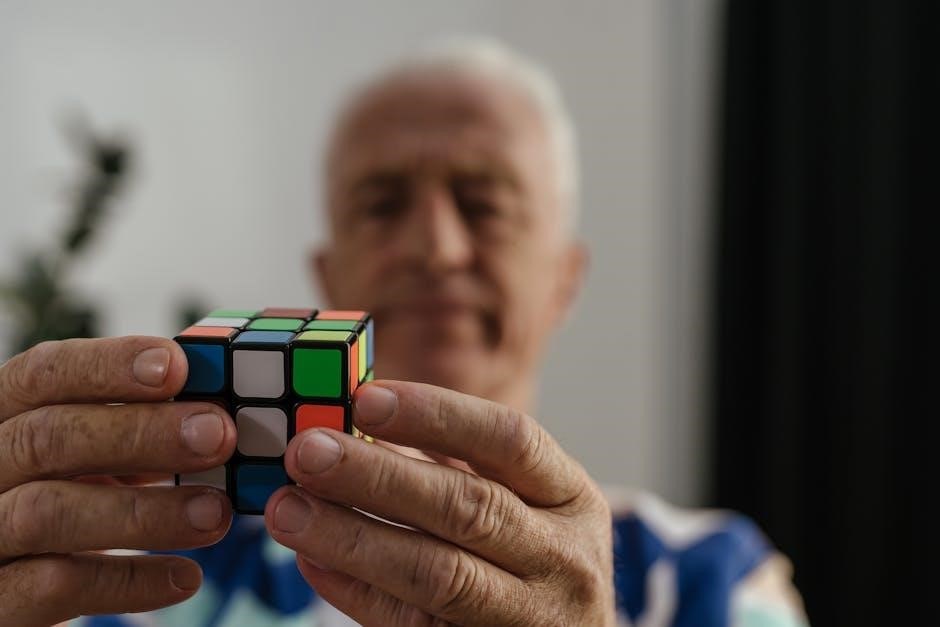The 2×2 Rubik’s Cube, also known as the Pocket Cube, is a smaller, simpler version of the classic 3×3 cube. It consists of 8 smaller cubes and is easier to solve due to fewer pieces. The goal is to rotate the faces to align all colors on each side. With only 3,674,140 possible configurations, it is a great introduction to speed solving and cube puzzles. Beginners can quickly master it using step-by-step guides or PDF tutorials available online, making it a perfect starting point for cube enthusiasts.
Understanding the Basics of the 2×2 Cube
The 2×2 Rubik’s Cube, or Pocket Cube, consists of 8 smaller cubes, each with colored stickers. Unlike the 3×3 cube, it has no fixed center pieces, making it more straightforward to solve. The cube is divided into layers, with each face capable of being rotated independently. Solving the 2×2 cube involves aligning all colors on each face, which can be achieved through simple algorithms. Its smaller size and fewer pieces make it a great introduction to cube solving, with only 3,674,140 possible configurations. This simplicity allows beginners to grasp the fundamentals quickly and enjoy the satisfaction of solving a Rubik’s Cube.
Why the 2×2 Cube is Easier Than the 3×3
The 2×2 Rubik’s Cube is simpler due to its smaller size and fewer pieces, making it more approachable for beginners. Unlike the 3×3 cube, it has no fixed center pieces, reducing complexity. With only 8 smaller cubes, the 2×2 requires fewer algorithms and steps to solve. Additionally, the absence of edge pieces means less confusion when aligning colors. This streamlined structure allows learners to focus on basic cube mechanics without the overwhelming complexity of the 3×3, making it an ideal starting point for mastering Rubik’s Cube puzzles.
The Ortega Method for Solving the 2×2 Cube
The Ortega Method is a popular, efficient approach to solving the 2×2 Rubik’s Cube, offering a straightforward, step-by-step system ideal for learners. Widely recommended for its clarity and effectiveness, it helps cubers master the puzzle quickly and confidently.
Step 1: Solve the First Layer
Begin by holding the cube in a comfortable position and identify the white cross on the bottom layer. Focus on solving one face at a time, ensuring all stickers align correctly. Start with the white face, turning only the top layer to match the colors. Once the first layer is solved, proceed to the next step. This foundational step is crucial for setting up the rest of the solve, so take your time to ensure accuracy and alignment.
Step 2: Orient the Final Layer
Hold the cube with the solved first layer on the bottom. Focus on the top layer and ensure all stickers are facing upwards. Use the Ortega method by performing R, L, and U turns to align the colors. If a sticker is misoriented, execute the algorithm R U R’ U’ to correct it. Repeat this process until all top-layer stickers are oriented correctly. This step ensures the final layer is prepared for permutation, making the remaining solve smoother. Patience is key to achieving proper orientation.
Step 3: Permute and Orient the Last Layer
With the first layer solved, focus on the final layer. Hold the cube so the solved layer is on the bottom. Use algorithms like R U R’ U’ or simple U turns to adjust the last pieces. Ensure all colors on the final layer are facing upwards and correctly aligned. If a piece is in the wrong position, perform the necessary moves to swap it without disturbing the solved parts. Patience is key, as this step requires precise execution to achieve the correct permutation and orientation of the remaining pieces.
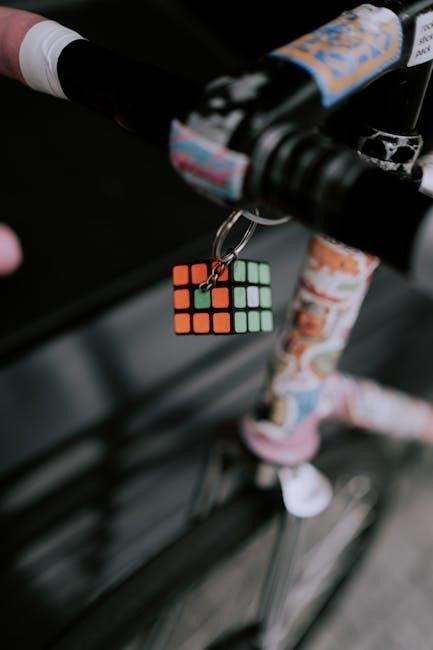
The 4-Stage Approach to Solving the 2×2 Cube
Learn the 4-stage method to solve the 2×2 cube: 1) Understand the cube mechanics, 2) Solve the first layer, 3) Orient the final layer, and 4) Make final adjustments for a solved cube.
Stage 1: Get to Know the Cube
Begin by understanding the 2×2 Rubik’s Cube structure. It has 8 smaller cubes, with one central cube and 7 movable pieces. Learn the terminology: corner pieces and face rotations. Familiarize yourself with how turning one face affects adjacent stickers. Practice rotating faces to see how they interact. This stage is about building intuition and comfort with the cube’s mechanics. Spend time observing how each move changes the cube’s appearance. Understanding these basics is essential before attempting to solve the cube. This foundational knowledge will help you progress smoothly to the next stages.
Stage 2: Solve the First Layer
Start by holding the cube with the white face on top. Focus on aligning the white stickers on the top and front faces. Rotate the top layer to match the white sticker with its corresponding center. If a piece is misaligned, flip the cube and repeat the process. Continue until the entire top layer is solved. This step establishes a solid foundation for the remaining stages. Keep practicing to ensure the first layer is solved efficiently and accurately every time.
Stage 3: Orient the Final Layer
Once the first layer is solved, focus on orienting the final layer. Hold the cube with the solved white face on top and the remaining unsolved pieces on the bottom. Twist the bottom layer to align the colors with their respective centers. If a piece is misaligned, flip the cube and repeat the process. Ensure all stickers on the bottom layer face outward correctly. This step requires patience and careful observation to avoid disrupting the solved top layer. Proper orientation is key before proceeding to the final adjustments.
Stage 4: Final Adjustments
After orienting the final layer, the last step involves making minor adjustments to ensure all pieces are correctly aligned. If any stickers are still misaligned, carefully twist the bottom layer while holding the top layer in place. Double-check each face to confirm all colors match their respective centers. Once everything aligns perfectly, the cube is solved. This stage requires attention to detail to ensure a flawless finish. Proper execution here guarantees a fully solved 2×2 Rubik’s Cube, completing the four-stage solving process effectively.
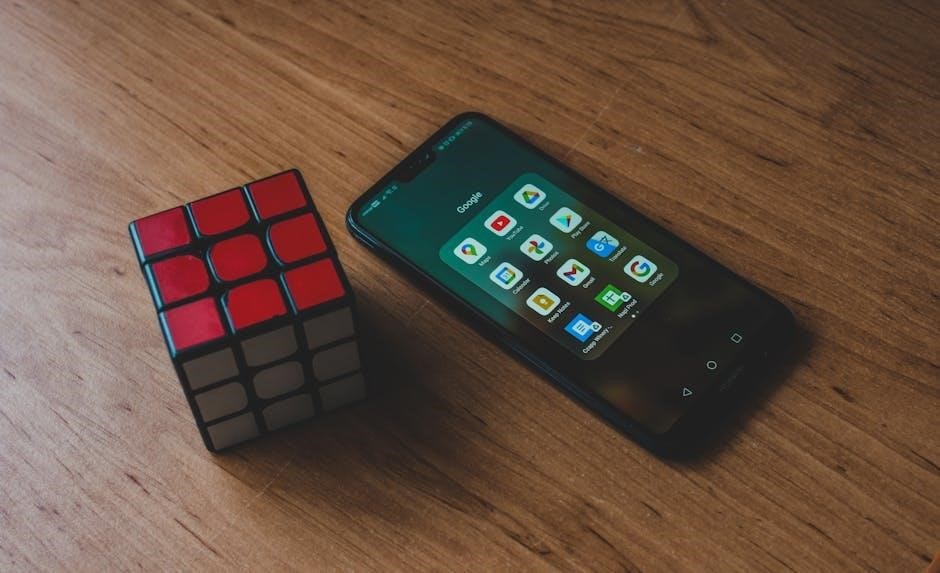
Algorithms for the 2×2 Rubik’s Cube
Algorithms are essential for solving the 2×2 cube efficiently. Basic moves like R, L, U, and D are foundational, while advanced techniques optimize speed and accuracy. Printable PDF guides provide step-by-step algorithms, helping beginners and speed solvers master the cube. Online simulators also offer visual solutions, making it easier to learn and practice these algorithms effectively for a faster solve.
Basic Algorithms for Beginners
Mastering basic algorithms is crucial for solving the 2×2 Rubik’s Cube. Start with simple moves like R (Right), L (Left), U (Up), and D (Down). These foundational algorithms help align pieces without disrupting the solved parts of the cube. For example, the “R U R'” sequence can help orient edges correctly. Printable PDF guides often include these essential algorithms, providing clear, step-by-step instructions for beginners to follow and practice. Regular practice of these algorithms builds muscle memory and improves solving efficiency.
Advanced Algorithms for Speed Solving
Advanced algorithms are essential for speed solving the 2×2 Rubik’s Cube. Techniques like T-perm, Y-perm, and Aa-perm allow for faster corner orientation and alignment. These algorithms are optimized for efficiency, reducing move count and solving time. PDF guides and online resources provide detailed explanations of these advanced methods, enabling solvers to improve their speed and precision. Regular practice of these algorithms, combined with finger independence, is key to mastering the 2×2 Cube at an advanced level and achieving sub-5-second solves consistently.
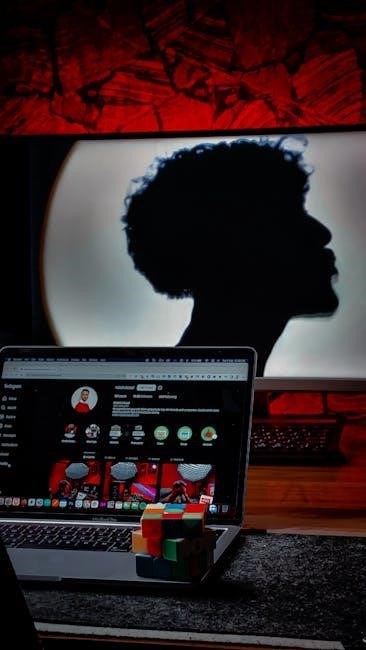
Online Tools and Resources for Solving the 2×2 Cube
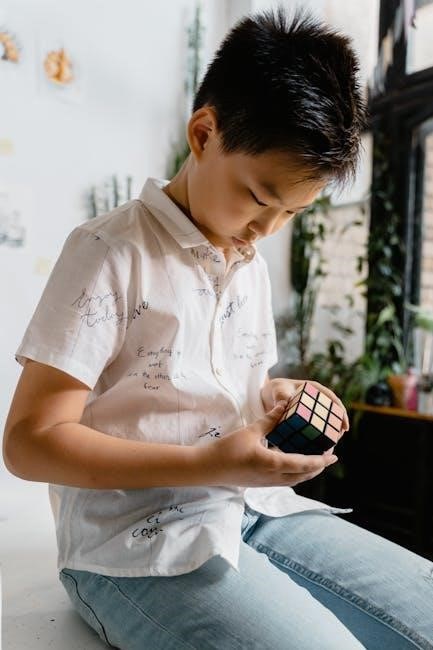
- 2×2 Rubik’s Cube Simulators allow virtual practice and solution testing.
- PDF Guides provide step-by-step instructions for beginners and advanced solvers.
- Algorithm Tutorials offer optimized moves for faster solving.
2×2 Rubik’s Cube Simulator
A 2×2 Rubik’s Cube Simulator is an interactive online tool that allows users to practice and solve the cube virtually. It provides a digital version of the Pocket Cube, enabling solvers to scramble and solve the cube without needing a physical one. The simulator often includes features like step-by-step solutions, algorithm generators, and solve trackers. It’s an excellent resource for beginners to learn basic moves and for advanced solvers to refine their speed-solving techniques. Many simulators also offer real-time feedback, helping users identify and correct mistakes instantly.
PDF Guides and Printable Instructions
PDF guides and printable instructions are excellent resources for learning to solve the 2×2 Rubik’s Cube. These documents provide step-by-step tutorials, diagrams, and algorithms to help users master the cube. Many guides are designed for beginners, breaking down the solution process into easy-to-follow phases. They often include visual aids and detailed explanations, making it easier to understand and practice each step. Printable instructions are particularly useful for those who prefer hands-on learning or need a reference while solving the cube. These resources are widely available online and cater to both basic and advanced solvers.

Speed Solving Techniques
Mastering speed solving requires practice, algorithm understanding, and efficient finger movements. Learn to solve the 2×2 cube in under 5 seconds by optimizing your solve process. Focus on quick recognition of patterns and smooth execution of moves. Regular practice helps improve muscle memory and reduces solve times. Advanced solvers use techniques like lookahead and pre-orientation to enhance speed. Perfecting these methods ensures faster solves and better overall performance, making you proficient in speed cubing competitions and casual solving sessions alike.
How to Solve the 2×2 Cube in Under 5 Seconds
To solve the 2×2 cube in under 5 seconds, master the Ortega method. Start by solving the first layer quickly, then focus on orienting the final layer. Use efficient algorithms and practice finger independence. Learn to recognize patterns rapidly and execute moves smoothly. Incorporate speed-solving techniques like “lookahead” to anticipate next steps. Regular practice with a timer improves speed and accuracy. Focus on minimizing unnecessary moves and optimizing your solve process. With consistent practice, you can achieve sub-5-second solves and impress with your cubing skills.
Tips for Improving Solve Speed
To improve your 2×2 Rubik’s Cube solve speed, practice consistently and understand the cube’s mechanics. Focus on finger independence to execute moves quickly and smoothly. Use “lookahead” to anticipate the next step while solving the current one. Optimize your algorithms to reduce unnecessary moves. Stay relaxed and avoid rushing, as tension slows you down. Regularly time your solves to track progress. Watch tutorials and learn from speed cubers’ techniques. Combine these tips with daily practice to achieve faster solve times and enhance your overall cubing efficiency.
Common Mistakes and How to Avoid Them
Common mistakes include misaligning pieces and using incorrect algorithms. Practice proper finger placement and ensure each move is precise. Regularly review tutorials to refine techniques and avoid errors.
Mistakes in the First Layer
Common errors in the first layer include misaligning pieces and incorrect turns. Ensure each move is precise and avoid twisting the wrong face. Practice proper finger placement to maintain the solved state of the first layer. Regularly review tutorials to refine techniques and prevent mistakes. Misaligning the top layer while solving the bottom can disrupt progress. Focus on one face at a time and use algorithms specifically designed for the 2×2 cube to avoid confusion. Patience and consistent practice are key to mastering the first layer without errors.
Mistakes in the Final Layer
Final layer errors often occur due to misaligned pieces and improper algorithm execution. Avoid over-rotating faces, as this can scramble the solved layers. Ensure the last layer is fully oriented before permuting. Forgetting to orient the final layer correctly can lead to unsolvable configurations. Practice algorithms slowly to maintain control and avoid skipping steps. Use online tools or PDF guides to verify each move and prevent common pitfalls. Rushing through the final steps is a frequent mistake; patience ensures accuracy and a solved cube. Regular practice helps minimize these errors and improves overall solving efficiency.

Practice and Mastery
Consistent practice builds muscle memory and improves solving speed. Start with short sessions, focusing on mastering basic techniques. Regular practice helps in understanding the cube’s mechanics deeply, ensuring long-term mastery and enjoyment of the puzzle.
How to Practice Effectively
To practice effectively, start with step-by-step guides and focus on mastering basic algorithms. Use online simulators to scramble the cube and solve it virtually. Track your progress by timing solves and analyzing common mistakes. Begin with short, focused sessions to build muscle memory. As you improve, gradually increase solve speed while maintaining accuracy. Stay motivated by setting achievable goals, such as solving the cube in under 10 seconds. Consistency is key to unlocking advanced techniques and mastering the 2×2 Rubik’s Cube.
- Use step-by-step guides for clarity.
- Practice basic algorithms regularly.
- Utilize online tools for virtual practice.
- Track progress to identify areas for improvement.
Mastering the 2×2 Cube for Beginners
Mastering the 2×2 Rubik’s Cube is an excellent starting point for beginners. Start by understanding the cube’s mechanics and basic movements. Use the Ortega method or the 4-stage approach to break down the solve into manageable steps. Begin with solving one face at a time, focusing on aligning colors without disturbing already solved pieces. Practice simple algorithms to orient and permute the final layer. As you progress, incorporate speed-solving techniques to improve efficiency. Consistency and patience are key to mastering this puzzle and building a strong foundation for more complex cubes.
- Start with one face and build from there.
- Use step-by-step methods like Ortega or 4-stage.
- Focus on basic algorithms first.
- Practice regularly to build muscle memory.
Mastering the 2×2 Rubik’s Cube is a rewarding journey that combines logic, patience, and practice. With structured methods like the Ortega and 4-stage approaches, beginners can quickly grasp the fundamentals. The availability of PDF guides, online simulators, and tutorials makes learning accessible and enjoyable. As you progress, speed-solving techniques and algorithms will enhance your skills. Remember, consistent practice is key to achieving mastery. Embrace the challenge and enjoy the satisfaction of solving this iconic puzzle, knowing you have a wealth of resources to guide you every step of the way.
